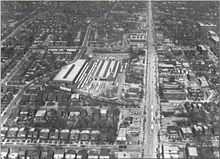Yonge streetcar line


The Toronto Transit Commission operated a Yonge streetcar line, on Yonge Street, from its creation from earlier private systems, in 1921, until the line was replaced by a heavy rail subway line, the Yonge Subway line, in 1954.[1] The TTCs Yonge line was its busiest and most congested, and the subway that replaced it was not only Toronto's first, but the first in Canada.
In 1885, prior to the TTC era, the Toronto and York Radial Railway introduced ′″radial″′′ streetcar service that connected Toronto to smaller municipalities north, of the city.[2] By 1909 this service had stretched all the way to Sutton, Ontario, on the shores of Lake Simcoe. The TTC continued to operate the radial service until 1930, planning to serve northern municipalities with diesel buses. However, the municipalities of Richmond Hill and York Township sponsored the resumption of service as far as Richmond Hill.
For the last several decades of streetcar service the TTC operated the Yonge line using Peter Witt Streetcars.[1] Even when the TTC operated a large fleet of more modern PCC streetcars they continued to use Peter Witt streetcars on Yonge. Peter Witt cars could be operated in pairs, using special cars called ′′″trailers″′′.
References
- ↑ 1.0 1.1 Ray Neilson. "Torontos Yonge Line, from Trailer Trains to subway". GPS Video. Retrieved 2014-02-20.
Yonge Street was one of Toronto’s first horse car lines to be converted to electric street cars in 1890.
- ↑ Mike Filey (2012). "Toronto Sketches 11: "The Way We Were"". Dundurn Press. pp. 175–176. ISBN 9781459707658. Retrieved 2014-02. Check date values in:
|accessdate=(help) - ↑ Mike Filey (1997). The TTC Story: The First Seventy-five Years. Dundurn Press. p. 62. ISBN 9781770700796. Retrieved 2014-02-17.